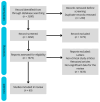The Impact of Environmental Factors on the Secretion of Gastrointestinal Hormones
- PMID: 40806130
- PMCID: PMC12348040
- DOI: 10.3390/nu17152544
The Impact of Environmental Factors on the Secretion of Gastrointestinal Hormones
Abstract
The enteroendocrine system of the gastrointestinal (GI) tract is the largest endocrine organ in the human body, playing a central role in the regulation of hunger, satiety, digestion, and energy homeostasis. Numerous factors-including dietary components, physical activity, and the gut microbiota-affect the secretion of GI hormones. This study aims to analyze how these factors modulate enteroendocrine function and influence systemic metabolic regulation. This review synthesizes the current scientific literature on the physiology and distribution of enteroendocrine cells and mechanisms of hormone secretion in response to macronutrients, physical activity, and microbial metabolites. Special attention is given to the interactions between gut-derived signals and central nervous system pathways involved in appetite control. Different GI hormones are secreted in specific regions of the digestive tract in response to meal composition and timing. Macronutrients, particularly during absorption, stimulate hormone release, while physical activity influences hormone concentrations, decreasing ghrelin and increasing GLP-1, PYY, and leptin levels. The gut microbiota, through fermentation and metabolite production (e.g., SCFAs and bile acids), modulates enteroendocrine activity. Species such as Akkermansia muciniphila are associated with improved gut barrier integrity and enhanced GLP-1 secretion. These combined effects contribute to appetite regulation and energy balance. Diet composition, physical activity, and gut microbiota are key modulators of gastrointestinal hormone secretion. Their interplay significantly affects appetite regulation and metabolic health. A better understanding of these relationships may support the development of personalized strategies for managing obesity and related disorders.
Keywords: CCK; GIP; GLP-1; PYY; environmental factors; gastrin; gastrointestinal hormones; ghrelin; obesity; secretin; somatostatin.
Conflict of interest statement
The authors declare no conflicts of interest.
Figures




Similar articles
-
From Gut to Brain: The roles of intestinal microbiota, immune system, and hormones in intestinal physiology and gut-brain-axis.Mol Cell Endocrinol. 2025 Sep 15;607:112599. doi: 10.1016/j.mce.2025.112599. Epub 2025 Jun 6. Mol Cell Endocrinol. 2025. PMID: 40482955 Review.
-
Prescription of Controlled Substances: Benefits and Risks.2025 Jul 6. In: StatPearls [Internet]. Treasure Island (FL): StatPearls Publishing; 2025 Jan–. 2025 Jul 6. In: StatPearls [Internet]. Treasure Island (FL): StatPearls Publishing; 2025 Jan–. PMID: 30726003 Free Books & Documents.
-
Selective release of gastrointestinal hormones induced by an orally active GPR39 agonist.Mol Metab. 2021 Jul;49:101207. doi: 10.1016/j.molmet.2021.101207. Epub 2021 Mar 9. Mol Metab. 2021. PMID: 33711555 Free PMC article.
-
Acute exercise and hormones related to appetite regulation: a meta-analysis.Sports Med. 2014 Mar;44(3):387-403. doi: 10.1007/s40279-013-0120-3. Sports Med. 2014. PMID: 24174308
-
T-bet expressing Tr1 cells driven by dietary signals dominate the small intestinal immune landscape.bioRxiv [Preprint]. 2025 Jul 4:2025.06.30.662190. doi: 10.1101/2025.06.30.662190. bioRxiv. 2025. PMID: 40747421 Free PMC article. Preprint.
References
-
- Prosapio J.G., Sankar P., Jialal I. StatPearls [Internet] StatPearls Publishing; Treasure Island, FL, USA: 2023. Physiology, Gastrin. - PubMed
Publication types
LinkOut - more resources
Full Text Sources

